Anatomy of flowering plant 1000+ MCQ with answer for SSC Stenographer
Thursday 9th of March 2023

Sharing is caring
1. T.S. of dicot stem is given below, certain parts have been marked by alphabets (A I). Choose the option which shows their correct labelling.

A. A Epidermis, B Epidermal hair, C Parenchyma, D Starch sheath, E Hypodermis (collenchyma), F Vascular bundle, G Bundle cap, H Medulla or pith, I Medullary rays
B. A Epidermal hair, B Epidermis, C Hypodermis (collenchyma), D Parenchyma, E Endoderm is (Starch Sheath), F Pericycle, G Vascular bundle, H Medullary rays, I Medulla or pith
C. A Epidermal hair, B Epidermis, C Hypodermis (collenchyma), D Starch sheath, E Parenchyma, F Vascular bundle, G Bundle cap, H Medulla or pith, I Medullary rays
D. A Epidermal hair, B Epidermis, C Parenchyma, D Hypodermis (collenchyma), E Starch sheath, F Vascular bundle, G Bundle cap, H Medulla or pith, I Medullary rays
Answer : B

A. A Epidermis, B Epidermal hair, C Parenchyma, D Starch sheath, E Hypodermis (collenchyma), F Vascular bundle, G Bundle cap, H Medulla or pith, I Medullary rays
B. A Epidermal hair, B Epidermis, C Hypodermis (collenchyma), D Parenchyma, E Endoderm is (Starch Sheath), F Pericycle, G Vascular bundle, H Medullary rays, I Medulla or pith
C. A Epidermal hair, B Epidermis, C Hypodermis (collenchyma), D Starch sheath, E Parenchyma, F Vascular bundle, G Bundle cap, H Medulla or pith, I Medullary rays
D. A Epidermal hair, B Epidermis, C Parenchyma, D Hypodermis (collenchyma), E Starch sheath, F Vascular bundle, G Bundle cap, H Medulla or pith, I Medullary rays
Answer : B
2. Match column-I with column-II and choose the correct option.
Which of the following combination is correct ?
A. A II, IV, VII, VIII; B I, III, V, VI
B. A I, II, VII, VIII; B III, IV, V, VI
C. A I, III, V, VI; B II, IV, VII, VIII
D. A I, III, VII, VIII; B II, IV, V, VI
Answer : C
| A. Spring wood or | I. Lighter in colour early wood |
|---|---|
| B. Autumn wood or | II. High density late wood |
| .. | III. Low density |
| .. | IV. Darker in colour |
| .. | V. Larger number of xylem elements |
| .. | VI. Vessels with wider cavity |
| .. | VII. Lesser number of xylem elements |
| .. | VIII. Vessels with small cavity |
Which of the following combination is correct ?
A. A II, IV, VII, VIII; B I, III, V, VI
B. A I, II, VII, VIII; B III, IV, V, VI
C. A I, III, V, VI; B II, IV, VII, VIII
D. A I, III, VII, VIII; B II, IV, V, VI
Answer : C
3. Main function of lenticel is
A. transpiration
B. guttation
C. gaseous exchange
D. both (a) & (c)
Answer : A
A. transpiration
B. guttation
C. gaseous exchange
D. both (a) & (c)
Answer : A
4. Which one of the following have vessels as their characteristic feature?
A. Angiosperms
B. Gymnosperms
C. Pteridophytes
D. Bryophytes
Answer : A
A. Angiosperms
B. Gymnosperms
C. Pteridophytes
D. Bryophytes
Answer : A
5. Read the following statements and answer the question.
Which type of wood is described by the above statements?
A. Sap wood
B. Heart wood
C. Spring wood
D. Autumn wood
Answer : C
- Cambium is very active and produces a large number of xylary elements having vessels with wider cavities.
- It is also called early wood.
- It is lighter in colour and has lower density.
Which type of wood is described by the above statements?
A. Sap wood
B. Heart wood
C. Spring wood
D. Autumn wood
Answer : C
6. The vessel elements of angiosperms differ from other elements of xylem in having
A. simple pits on their radial walls.
B. bordered pits on their lateral walls.
C. simple and bordered pits on their end walls.
D. simple perforation on their end walls.
Answer : D
A. simple pits on their radial walls.
B. bordered pits on their lateral walls.
C. simple and bordered pits on their end walls.
D. simple perforation on their end walls.
Answer : D
7. In an experiment, a student cut a transverse section of young stem of a plant which he has taken from his school garden.
After observing it under the microscope how would he ascertain whether it is a monocot stem or a dicot stem?
A. With the help of bulliform cells.
B. With the help of casparian strips.
C. With the help of vascular bundles.
D. With the help of stomatal apparatus.
Answer : C
After observing it under the microscope how would he ascertain whether it is a monocot stem or a dicot stem?
A. With the help of bulliform cells.
B. With the help of casparian strips.
C. With the help of vascular bundles.
D. With the help of stomatal apparatus.
Answer : C
8. A plant tissue when stained showed the presence of hemicellulose and pectin in cells wall of its cells. The tissue is called
A. collenchyma
B. sclerenchyma
C. xylem
D. meristem
Answer : A
A. collenchyma
B. sclerenchyma
C. xylem
D. meristem
Answer : A
9. When we peel the skin of a potato tuber, we remove
A. periderm
B. epidermis
C. cuticle
D. leaves
Answer : A
A. periderm
B. epidermis
C. cuticle
D. leaves
Answer : A
10. Which of the following statements are correct ?
A. (i) and (iii)
B. (i) and (ii)
C. (iii) and (iv)
D. (i) and (iv)
Answer : B
- Xylem transports water and minerals.
- Gymnosperms lack sieve tubes and companion cells in phloem.
- The first formed primary xylem is called metaxylem.
- Phloem fibres (bast fibres) are made up of collenchymatous cells.
A. (i) and (iii)
B. (i) and (ii)
C. (iii) and (iv)
D. (i) and (iv)
Answer : B
11. Which type of plant tissue is being described by the given statements?
A. Parenchyma
B. Sclerenchyma
C. Collenchyma
D. Chlorenchyma
Answer : B
- It consists of long, narrow cells with thick and lignified cell walls having a few or numerous pits.
- They are dead and without protoplasts.
- On the basis of variation in form, structure, origin and development, it may be either fibres or sclereids.
- It provides mechanical support to organs.
A. Parenchyma
B. Sclerenchyma
C. Collenchyma
D. Chlorenchyma
Answer : B
12. In stems, the protoxylem lies towards the _____________ and the metaxylem lies towards the ____________ of the organ.
A. centre; periphery
B. periphery; centre
C. periphery; periphery
D. centre; centre
Answer : A
A. centre; periphery
B. periphery; centre
C. periphery; periphery
D. centre; centre
Answer : A
13. Sclerenchyma usually___________and_____________ protoplasts.
A. live, without
B. dead, with
C. live, with
D. dead, without
Answer : D
A. live, without
B. dead, with
C. live, with
D. dead, without
Answer : D
14. Which of the following statement(s) is/are correct ?
A. (i) and (iv) only
B. (ii) and (v) only
C. (iii) and (iv) only
D. (ii), (iii) and (v) only
Answer : D
- Uneven thickening of cell wall is characteristic of sclerenchyma.
- Periblem forms cortex of the stem and the root.
- Tracheids are the chief water transporting elements in gymnosperms.
- Companion cell is devoid of nucleus at maturity.
- The commercial cork is obtained from Quercus suber.
A. (i) and (iv) only
B. (ii) and (v) only
C. (iii) and (iv) only
D. (ii), (iii) and (v) only
Answer : D
15. A narrow layer of thin walled cells found between phloem/ bark and wood of a dicot is
A. cork cambiumB. vascular cambium
C. endodermis
D. both (a) & (c)
Answer : B
A. cork cambium
C. endodermis
D. both (a) & (c)
Answer : B
16. Which meristem helps in increasing girth?
A. Lateral meristem
B. Intercalary meristem
C. Primary meristem
D. Apical meristem
Answer : A
A. Lateral meristem
B. Intercalary meristem
C. Primary meristem
D. Apical meristem
Answer : A
17. In land plants, the guard cells differ from other epidermal cells in having
A. cytoskeleton.
B. mitochondria.
C. endoplasmic reticulum.
D. chloroplasts.
Answer : D
A. cytoskeleton.
B. mitochondria.
C. endoplasmic reticulum.
D. chloroplasts.
Answer : D
18. A student was given a tissue to observe under the microscope. He observes the tissue and concludes that the tissue is a type of simple plant tissue and provides mechanical support to young stem and petiole of leaf.
Identify the tissue.
A. Parenchyma
B. Collenchyma
C. Sclerenchyma
D. Xylem parenchyma
Answer : B
Identify the tissue.
A. Parenchyma
B. Collenchyma
C. Sclerenchyma
D. Xylem parenchyma
Answer : B
19. The given figure shows apical meristem of root apex with few part marked as A, B and C. Identify the correct labelling of A, B and C.
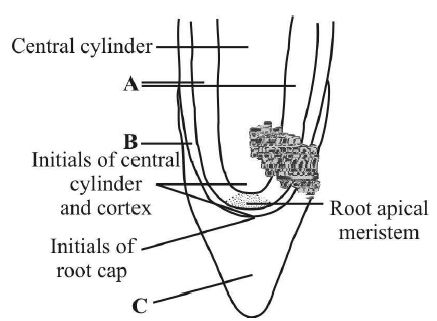
A. A Vascular structure, B Protoderm, C Root cap
B. A Cortex, B Endodermis, C Root cap
C. A Cortex, B Protoderm, C Root cap
D. A Tunica, B Protoderm, C Root cap
Answer : C

A. A Vascular structure, B Protoderm, C Root cap
B. A Cortex, B Endodermis, C Root cap
C. A Cortex, B Protoderm, C Root cap
D. A Tunica, B Protoderm, C Root cap
Answer : C
20. The given figures are types of elements (A and B) which constitute one type of complex tissue (c) of a plant . Identify A, B and C.
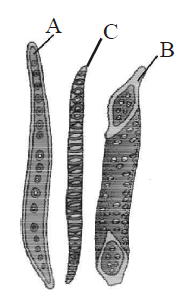
A. A Tracheid, B Vessel, C Xylem
B. A Vessel, B Tracheild, C Phloem
C. A Fibre, B Tracheid, C Bark
D. A Fibre, B Sclereid, C Casparian strips
Answer : A

A. A Tracheid, B Vessel, C Xylem
B. A Vessel, B Tracheild, C Phloem
C. A Fibre, B Tracheid, C Bark
D. A Fibre, B Sclereid, C Casparian strips
Answer : A
21. Match column-I with column-II and select the correct option from the codes given below.
A. A IV, B I, C II, D III
B. A III, B II, C I, D IV
C. A I, B II, C III, D IV
D. A IV, B II, C I, D III
Answer : A
| Column-I | Column-II |
|---|---|
| A. Stele | I. Innermost layer of cortex |
| B. Endodermis | II. Suberin |
| C. Casparian strips | III. All the tissues exterior to vascular cambium |
| D. Bark | IV. All the tissues inner to endodermis |
A. A IV, B I, C II, D III
B. A III, B II, C I, D IV
C. A I, B II, C III, D IV
D. A IV, B II, C I, D III
Answer : A
22. Which of the following statement(s) is/are not correct?
A. (iii) and (iv)
B. (i) and (ii)
C. (ii) and (iii)
D. (ii) and (iv)
Answer : A
- Cork cambium is also called phellogen.
- Cork is also called phellem.
- Secondary cortex is also called periderm.
- Cork cambium, cork and secondary cortex are collectively called phelloderm.
A. (iii) and (iv)
B. (i) and (ii)
C. (ii) and (iii)
D. (ii) and (iv)
Answer : A
23. Choose the correct labelling of (A J) in the given figure of T.S. of monocot root.

A. A Root hair, B Epiblema, C Cortex, D Endodermis, E Passage cell, F Pericycle, G Pith, H Phloem, I Metaxylem.
B. A Root hair, B Epiblema, C Cortex, D Endodermis, E Passage cell, F Pith, G Pericycle, H Metaxylem, I Phloem.
C. A Root hair, B Epiblema, C Cortex, D Endodermis, E Pericycle, F Phloem, G Protoxylem, I Metaxylem
D. A Root hair, B Cortex, C Epiblema, D Pericycle, E Endodermis, F Pith, G Phloem, H Protoxylem, I Metaxylem
Answer : C

A. A Root hair, B Epiblema, C Cortex, D Endodermis, E Passage cell, F Pericycle, G Pith, H Phloem, I Metaxylem.
B. A Root hair, B Epiblema, C Cortex, D Endodermis, E Passage cell, F Pith, G Pericycle, H Metaxylem, I Phloem.
C. A Root hair, B Epiblema, C Cortex, D Endodermis, E Pericycle, F Phloem, G Protoxylem, I Metaxylem
D. A Root hair, B Cortex, C Epiblema, D Pericycle, E Endodermis, F Pith, G Phloem, H Protoxylem, I Metaxylem
Answer : C
24. Bast fibres are made up of _____________cells.
A. sclerenchymatous
B. chlorenchymatous
C. parenchymatous
D. aerenchymatous
Answer : A
A. sclerenchymatous
B. chlorenchymatous
C. parenchymatous
D. aerenchymatous
Answer : A
25. Cambium is considered as a lateral meristem because
A. it gives rise to lateral branches.
B. it causes increase in girth.
C. it increases height and diameter of a plant.
D. it adds bulk to a plant.
Answer : B
A. it gives rise to lateral branches.
B. it causes increase in girth.
C. it increases height and diameter of a plant.
D. it adds bulk to a plant.
Answer : B
26. Various functions like photosynthesis, storage, excretion performed by _____________.
A. sclerenchyma
B. parenchyma
C. collenchyma
D. aerenchyma
Answer : B
A. sclerenchyma
B. parenchyma
C. collenchyma
D. aerenchyma
Answer : B
27. Match the names of the structures given in column-I with the functions given in column-II, choose the answer which gives the correct combination of the two columns :
A. A V, B III, C I, D IV
B. A I, B IV, C V, D III
C. A II, B IV, C I, D III
D. A IV, B I, C III, D V
Answer : D
| Column-I | Column-II |
|---|---|
| (Structure) | (Function) |
| A. Stomata | I. Protection of stem |
| B. Bark | II. Plant movement |
| C. Cambium | III. Secondary growth |
| D. Cuticle | IV. Transpiration |
| V. Prevent the loss of water | ... |
A. A V, B III, C I, D IV
B. A I, B IV, C V, D III
C. A II, B IV, C I, D III
D. A IV, B I, C III, D V
Answer : D
28. Match the elements of xylem given in column I with their character given in the column II and choose the correct option.
A. A IV; B III; C II; D I
B. A III; B II; C I; D IV
C. A II; B I; C IV; D III
D. A III; B IV; C II; D I
Answer : D
| Column-I | Column-II |
|---|---|
| A. Xylem vessels | I. Store food materials |
| B. Xylem tracheids | II. Obliterated lumen |
| C. Xylem fibres | III. Perforated plates |
| D. Xylem parenchyma | IV. Chisel-like ends |
A. A IV; B III; C II; D I
B. A III; B II; C I; D IV
C. A II; B I; C IV; D III
D. A III; B IV; C II; D I
Answer : D
29. Tissues are classified into two main groups, namely meristematic and permanent tissues on the basis of
A. whether the cells being able to divide or not.
B. position of the cells.
C. whether they are living or dead.
D. none of the above
Answer : A
A. whether the cells being able to divide or not.
B. position of the cells.
C. whether they are living or dead.
D. none of the above
Answer : A
30. Match column-I with column-II and choose the correct option.
A. A III, B V, C IV, D I, E II
B. A II, B V, C I, D III, E IV
C. A II, B IV, C I, D III, E V
D. A III, B I, C V, D II, E IV
Answer : D
| Column -I | Column -II |
|---|---|
| A. Bulliform cells | I. Initiation of lateral roots |
| B. Pericycle | II. Root |
| C. Endarch xylem | III. Grasses |
| D. Exarch xylem | IV. Dicot leaf |
| E. Bundle sheath cells | V. Stem |
A. A III, B V, C IV, D I, E II
B. A II, B V, C I, D III, E IV
C. A II, B IV, C I, D III, E V
D. A III, B I, C V, D II, E IV
Answer : D
31. The given figure shows the T.S of dicot root. Some parts are marked as A, B, C, D, E, & F. Choose the option which shows the correct labelling of marked part.

A. A Epiblema, B Root hair, C Cortex, D Endodermis, E Pith, F Pericycle
B. A Cortex, B Pith, C Epiblema, D Endodermis, E Root hair, F Pericycle
C. A Epiblema, B Endodermis, C Cortex, D Root hair, E Pith, F Pericycle
D. A Cortex, B Epiblema, C Pith, D Endodermis, E Root hair, F Pericycle
Answer : D

A. A Epiblema, B Root hair, C Cortex, D Endodermis, E Pith, F Pericycle
B. A Cortex, B Pith, C Epiblema, D Endodermis, E Root hair, F Pericycle
C. A Epiblema, B Endodermis, C Cortex, D Root hair, E Pith, F Pericycle
D. A Cortex, B Epiblema, C Pith, D Endodermis, E Root hair, F Pericycle
Answer : D
32. Identify the types of simple tissue indicated by A, B, C and D and their function.
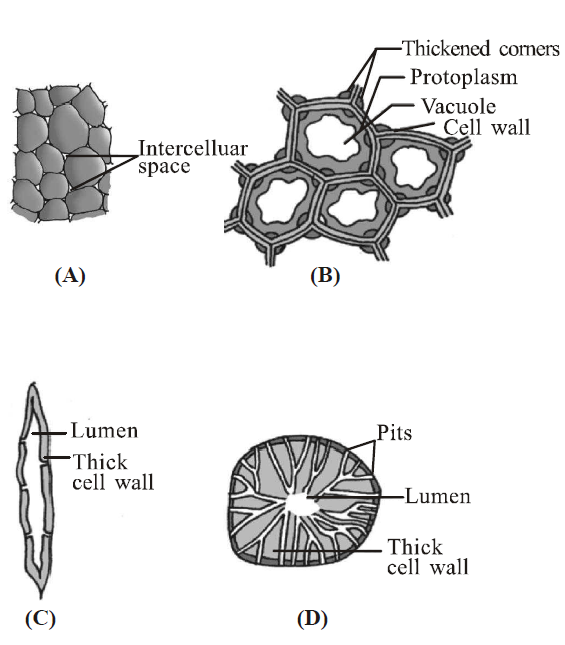
A. A Parenchyma, Photosynthesis, Storage and Secretion.
B. B Sclerenchyma Scleriods; Transport food material
C. C Collenchyma; Provides mechanical support to organs.
D. D Sclerenchyma Fibres; Provide Mechanical support to the growing parts of the plant such as young stem and petiole of a leaf.
Answer : A

A. A Parenchyma, Photosynthesis, Storage and Secretion.
B. B Sclerenchyma Scleriods; Transport food material
C. C Collenchyma; Provides mechanical support to organs.
D. D Sclerenchyma Fibres; Provide Mechanical support to the growing parts of the plant such as young stem and petiole of a leaf.
Answer : A
33. Cells of permanent tissues are specialized
A. functionally.
B. only structurally.
C. both structurally and functionally.
D. for mitosis.
Answer : C
A. functionally.
B. only structurally.
C. both structurally and functionally.
D. for mitosis.
Answer : C
34. Which of the following is responsible for the formation of an embryonic shoot called axillary bud?
A. Lateral meristem
B. Apical meristem
C. Intercalary meristem
D. Both
Answer : C
A. Lateral meristem
B. Apical meristem
C. Intercalary meristem
D. Both
Answer : C
35. Which of following helps bamboo and grasses to elongate ?
A. Apical meristems
B. Lateral meristems
C. Secondary meristems
D. Intercalary meristems
Answer : D
A. Apical meristems
B. Lateral meristems
C. Secondary meristems
D. Intercalary meristems
Answer : D
36. Phellogen and phellem respectively denote
A. cork and cork cambium,
B. cork cambium and cork,
C. secondary cortex and cork,
D. cork and secondary cortex,
Answer : B
A. cork and cork cambium,
B. cork cambium and cork,
C. secondary cortex and cork,
D. cork and secondary cortex,
Answer : B
37. As secondary growth proceeds, in a dicot stem, the thickness of
A. sapwood increases.
B. heartwood increase.
C. both sapwood and heartwood increases.
D. both sapwood and heartwood remains the same.
Answer : C
A. sapwood increases.
B. heartwood increase.
C. both sapwood and heartwood increases.
D. both sapwood and heartwood remains the same.
Answer : C
38. Which of the following statements is correct?
A. Lenticels occur in most woody trees.
B. Sclerenchymatous cells are usually present in cortex.
C. The vascular tissue system is divided into three main zones- cortex, pericycle and pith.
D. The conjoint vascular bundles usually have the xylem located only on the outer side of the phloem.
Answer : A
A. Lenticels occur in most woody trees.
B. Sclerenchymatous cells are usually present in cortex.
C. The vascular tissue system is divided into three main zones- cortex, pericycle and pith.
D. The conjoint vascular bundles usually have the xylem located only on the outer side of the phloem.
Answer : A
39. Sieve tubes are suited for translocation of food because they possess
A. bordered pits.
B. no ends walls.
C. broader lumen and perforated cross walls.
D. no protoplasm.
Answer : C
A. bordered pits.
B. no ends walls.
C. broader lumen and perforated cross walls.
D. no protoplasm.
Answer : C
40. The length of different internodes in a culm of sugarcane is variable because of
A. size of leaf lamina at the node below each internode
B. intercalary meristem
C. shoot apical meristem
D. position of axillary buds
Answer : B
A. size of leaf lamina at the node below each internode
B. intercalary meristem
C. shoot apical meristem
D. position of axillary buds
Answer : B
41. Match the followings and choose the correct option
A. A III, B IV, C I, D II
B. A I, B II, C III, D IV
C. A III, B II, C IV, D I
D. A III, B II, C I, D IV
Answer : A
| Column-I | Column-II |
|---|---|
| A. Cuticle | I. Guard cells |
| B. Bulliform cells | II. Outer layer |
| C. Stomata | III. Waxy layer |
| D. Epidermis | IV. Empty colourless cell |
A. A III, B IV, C I, D II
B. A I, B II, C III, D IV
C. A III, B II, C IV, D I
D. A III, B II, C I, D IV
Answer : A
42. One of the primary function of the ground tissue in a plant is
A. photosynthesis.
B. to protect the plant.
C. to anchor the plant.
D. water and sugar conduction.
Answer : A
A. photosynthesis.
B. to protect the plant.
C. to anchor the plant.
D. water and sugar conduction.
Answer : A
43. A piece of wood having no vessels (trachea) must be belonged to
A. teak
B. mango
C. pine
D. palm
Answer : C
A. teak
B. mango
C. pine
D. palm
Answer : C
44. A vascular bundle in which the protoxylem is pointing to the periphery is called __________.
A. endarch
B. exarch
C. radial
D. closed
Answer : B
A. endarch
B. exarch
C. radial
D. closed
Answer : B
45. Cork cambium and vascular cambium are
A. the parts of secondary xylem and phloem.
B. the parts of pericycle.
C. lateral meristems.
D. apical meristems.
Answer : C
A. the parts of secondary xylem and phloem.
B. the parts of pericycle.
C. lateral meristems.
D. apical meristems.
Answer : C
46. Gymnosperms are also called soft wood spermatophytes because they lack
A. cambium
B. phloem fibres
C. thick-walled tracheids
D. xylem fibres
Answer : D
A. cambium
B. phloem fibres
C. thick-walled tracheids
D. xylem fibres
Answer : D
47. Identify A, B and C in the given figure of shoot apical meristem
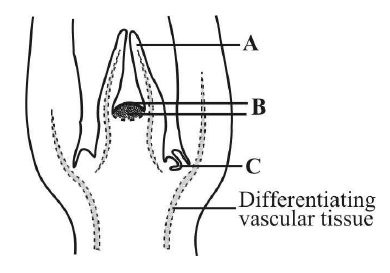
A. A Leaf primordium, B Shoot apical meristem, C Axillary bud
B. A Leaf primordium, B Shoot apical meristem, C Apical bud
C. A Root hair primordium, B Root apical meristem, C Axillary bud
D. A Root hair primordium, B Root apical meristem, C Terminal bud
Answer : A

A. A Leaf primordium, B Shoot apical meristem, C Axillary bud
B. A Leaf primordium, B Shoot apical meristem, C Apical bud
C. A Root hair primordium, B Root apical meristem, C Axillary bud
D. A Root hair primordium, B Root apical meristem, C Terminal bud
Answer : A
48. Apical and intercalary meristems are primary meristems because
A. they occur in the mature region of roots and shoots of many plants.
B. they made up of different kinds of tissues.
C. they involved in secondary growth.
D. they appear early in life of a plant and contribute to the formation of the primary plant body.
Answer : D
A. they occur in the mature region of roots and shoots of many plants.
B. they made up of different kinds of tissues.
C. they involved in secondary growth.
D. they appear early in life of a plant and contribute to the formation of the primary plant body.
Answer : D
49. Which one of the followings option shows the correct labelling of the parts marked as A, B, C and D in the given figure a lenticel?
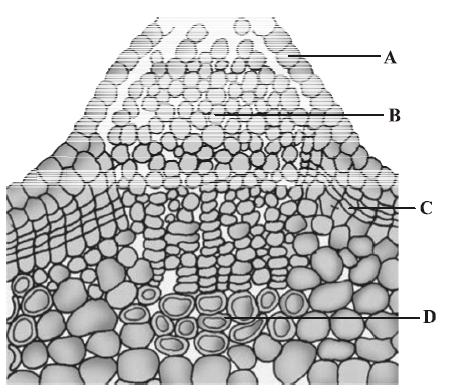
A. A Epidermis, B Secondary cortex, C Cork cambium, D Cork
B. A Pore, B Cork cambium, C Secondary cortex, D Cork
C. A Pore, B Cork, C Complimentary cells, D Cork cambium
D. A Epidermis, B Complimentary cells, C Cork cambium, D Secondary cortex
Answer : D

A. A Epidermis, B Secondary cortex, C Cork cambium, D Cork
B. A Pore, B Cork cambium, C Secondary cortex, D Cork
C. A Pore, B Cork, C Complimentary cells, D Cork cambium
D. A Epidermis, B Complimentary cells, C Cork cambium, D Secondary cortex
Answer : D
50. Identify types of vascular bundles in given figures A, B and C.
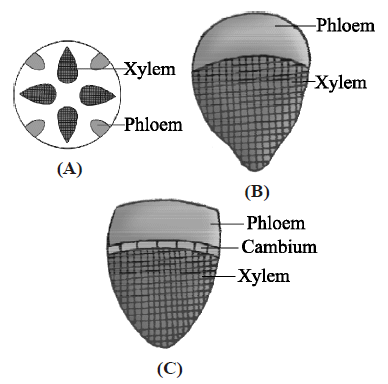
A. Radial; Conjoint closed; Conjoint open
B. Conjoint closed; Conjoint open; Radial
C. Conjoint open; Conjoint closed; Radial
D. Bicollateral; Concentric; Radial
Answer : A

A. Radial; Conjoint closed; Conjoint open
B. Conjoint closed; Conjoint open; Radial
C. Conjoint open; Conjoint closed; Radial
D. Bicollateral; Concentric; Radial
Answer : A
Sharing is caring
Related Post
1000+ Radiologic Examination MCQ for IBPS PO [Solved]
Anatomy of flowering plant 1000+ MCQ with answer for RRB NTPC
1000+ Airport Engineering MCQ for RBI Assistant [Solved]
1000+ Operating System Multiple Choice Question Answer [Solved]
1000+ Current Affairs December 2022 Multiple Choice Question Answer [Solved]
1000+ Microsoft PowerPoint MCQ for RBI Grade B officer [Solved]